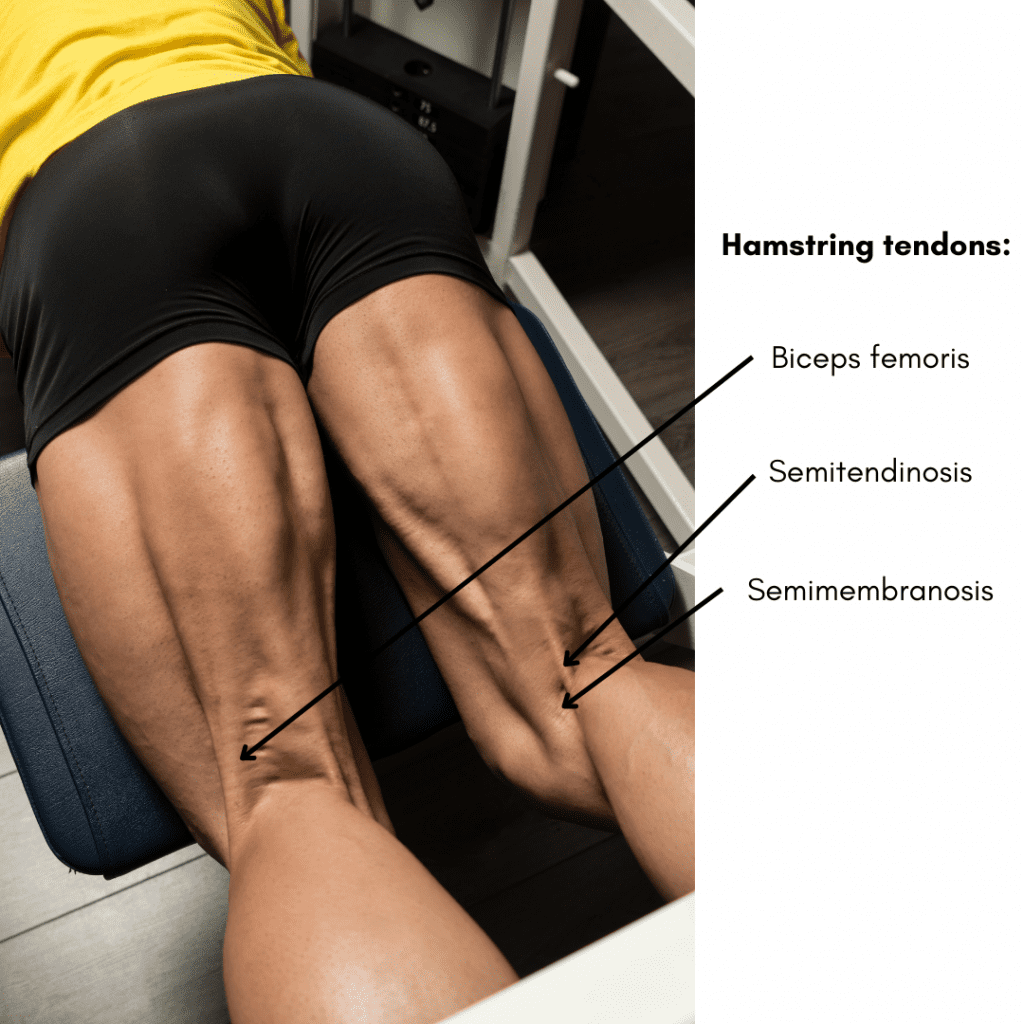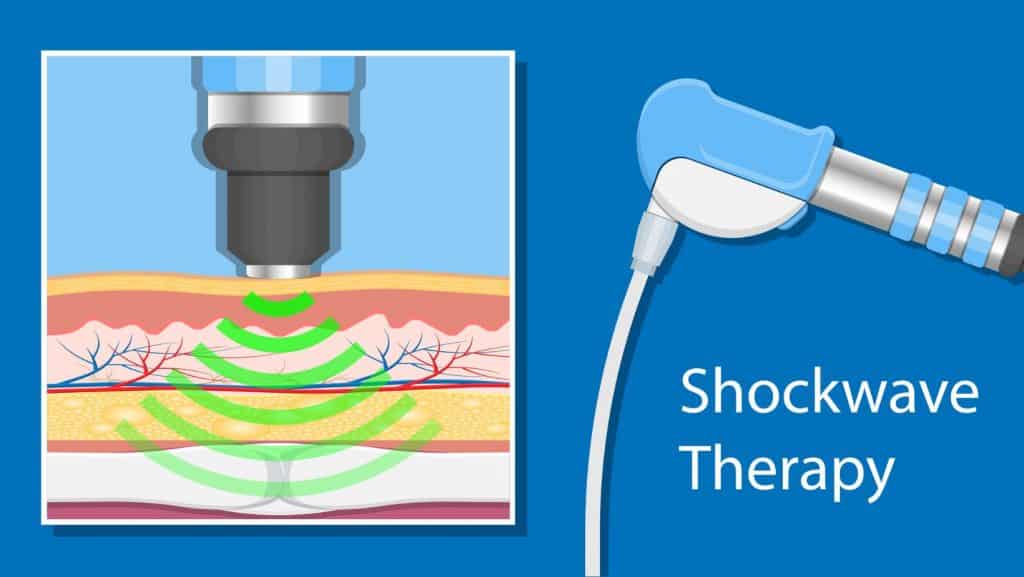Pes Anserine Bursitis
Read More >
Distal Hamstring Tendonitis results in pain in the lower hamstring tendons that attach to the back of the knee. The hamstring group comprises 3 individual muscles: the biceps femoris, semimembranosus and semitendinosus.
These 3 muscles have a common origin at the bottom of the pelvis at the seat bone, called the ischial tuberosity. The semimembranosus and semitendinosus run down to the medial side of the knee, attaching to the medial condyle of the tibia, and the biceps femoris runs down more laterally, attaching to the head of the fibula.
Hamstring tendonitis can occur at the proximal or distal tendon of the hamstring muscle. The proximal hamstring tendon is closer to the hip, while the distal is closer to the back of the knee.
Hamstring tendonitis is one of the most common causes of hamstring tendon pain. Other causes of hamstring tendon pain are hamstring tendon tear or hamstring tendon strain. Distal hamstring tendonitis is also known as low hamstring tendonitis.
In this article, we will discuss distal (low) hamstring tendonitis, its causes, diagnosis and treatment.

Hamstring tendonitis is, in most cases, an overuse injury. It is commonly seen in endurance sports with high training volumes, such as running, cycling and triathlon.
A common cause is training errors, where an increase in the volume of training or intensity of training changes at a rate that is too great for the tendon to recover from.
The hamstrings work primarily during acceleration and deceleration, so sports with a lot of change of direction or stopping and sprinting can lead to an overload of the tendon.
There can be biomechanical causes, such as over-pronation of the foot or a high Q angle at the hip for semimembranosus tendinopathy, biceps femoris tendinopathy and varus knees.
Additionally, there is a high incidence of low hamstring tendinopathy if a hamstring graft has been used for an ACL reconstructive surgery.

Distal hamstring tendonitis symptoms vary from person to person.
Most patients will experience pain local to the tendon. It can be painful to touch or squeeze it.
The pain is mechanical, so loading the tendon with a hamstring curl or bridge exercise can aggravate the symptoms.
Pain at the back of the knee is common alongside upper calf pain.
Sometimes, a lump on or thickening around the tendon is present.
Depending on severity, some people will feel stiffness and pain after periods of rest or first thing in the morning.
Symptoms often improve with movement but with excess activity and use of the hamstring, pain can return and may feel more stiff after the next period of rest.
If you suspect you have hamstring tendonitis, you should see a sports doctor or physical therapist for an assessment. A medical practitioner will carry out a thorough examination, looking at your movements, strength and flexibility and special tests for the hamstring.
In addition to a physical examination, diagnosis can be supported and confirmed with diagnostic imaging such as ultrasound and MRI scans.
Physical Therapy and rehabilitation is the best treatment for Distal Hamstring Tendonitis. In the acute stages of injury, it can be helpful to reduce the load being placed through the tendon. If you run, consider decreasing your volume by 20-30% and similarly with walking or rowing.
Anti-inflammatories can help to reduce inflammation during the acute stages of the injury, but you should consult your GP before consuming any of these.
In the acute stage (0-72 hours), we recommend that you refrain from stretching the tendon as this can worsen the symptoms. Consider non-impact exercises such as swimming or cycling to maintain cardiovascular symptoms.
Isometric strengthening exercises can commence immediately post-injury before beginning strengthening exercises through range alongside stretching. We have created an article on the best exercises for Distal Hamstring Tendonitis.

Shockwave, or extracorporeal shockwave therapy (ESWT), is a relatively new treatment used for tendon recovery. ESWT uses sound energy waves to reduce the sensitivity of nerves and cause micro-damage to the affected area.
Micro-damage causes a bodily response of increased blood flow and metabolism, which can speed up healing. There is an increasing body of evidence to suggest the efficacy of ESWT for musculoskeletal injury recovery and pain reduction at any phase of rehabilitation (Korakakis et al, 2018).
There is varied quality evidence for dry needling and acupuncture treatments regarding whether they improve tissue healing. There is some evidence that acupuncture can improve tendon blood flow and fibroblastic activity (Neal & Longbottom, 2012) and that it produces short-term pain relief for musculoskeletal disorders (Wrigth & Sluka, 2001).
As a treatment modality that is very safe with minimal side effects, it has been regularly recommended as an adjunctive treatment for tendonitis recovery.
If conservative treatments such as physical therapy, including exercise rehab, taping, braces, and shockwave, are not effective in resolving hamstring tendonitis. In that case, you might be offered medication in the form of non-steroidal anti-inflammatories or a locally administered cortisone injection.
A hamstring tendon injection of cortisone is used to reduce inflammation and pain. After the initial rest period, the injection can reduce pain and allow you to progress with exercises and rehabilitation to strengthen and condition the tendon.
Cortisone injections are used cautiously as they can cause long-term harm to the integrity of the tendon.
How long does hamstring tendonitis last?
In our experience, Hamstring tendonitis lasts 6-12 weeks. If the symptoms of Hamstring tendonitis are quickly identified and the correct treatment quickly begins, it can take 6 weeks to recover. If a patient has long-standing hamstring tendonitis, it can take up to 12 weeks to recover under the guidance of a Physical therapist. The general health of the individual will affect healing time as well as specific lifestyle factors; drinking alcohol and smoking will both increase recovery time.
Can massage help hamstring tendonitis?
Massage can help hamstring tendonitis by reducing spasm and relaxing muscles. Massage is often used for these benefits with musculoskeletal injuries, to improve healing and speed up recovery time. Deep tissue massage is effective for relaxation and reducing tone. Deep transverse friction massage can be helpful for short-term pain relief.
Can you run with hamstring tendonitis?
Yes, in the majority of cases, you can continue to run with hamstring tendonitis. We rarely recommend patients to stop running with Hamstring tendonitis as it can lead to deconditioning of the tendon, but it is important to modify your running. Consider avoiding uphill running and avoid high-end pace running or intervals. Increase the rest period between runs and replace them with non-impact activities. If you plan to continue running with your injury, you should consult your physical therapist to check if this is sensible. They can assess your running style and ensure this does not negatively impact your recovery time.
This article is written by James McCormack, a Lower Limb Specialist who is an expert in treating Distal Hamstring Tendonitis.
This is not medical advice. We recommend a consultation with a medical professional such as James McCormack if you are experiencing any of the symptoms discussed in this article.
James offers Online Physiotherapy Appointments weekly and face-to-face appointments in his London clinic.